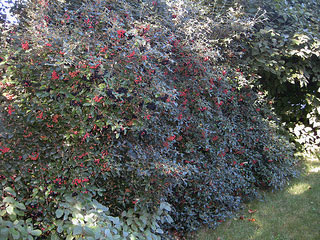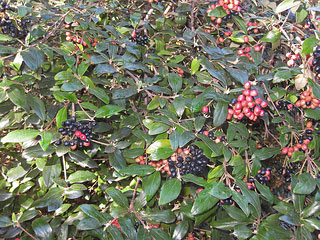Resource Library
Plant of the Week: Conoy Viburnum
Conoy Viburnum
Latin: Viburnum ×burkwoodii 'Conoy'
Fifteen-year-old Conoy viburnum is about 5 feet tall and 7 feet wide. (Image courtesy Gerald Klingaman)
Conoy viburnum is an evergreen viburnum growing 5 to 6 feet tall and about 8 to9 feet wide with a dense, generally mounded habit of growth. The deep, glossy green leaves are about 2.5 inches long and 1 inch wide with a soft pubescence on the undersurface. In the winter the leaves take on a purplish shade and curl inward during cold weather.
The terminal clusters of pink flower buds that open white are slightly fragrant and produced in dense 2- to 3-inch heads in mid- to late April. In late summer and early fall the ripening clusters of one-third-inch long berries transition in stages from red to black as the fruit mature.
This hybrid viburnum was developed by the late Dr. Donald Egolf who worked for more than 30 years as a plant breeder at the U.S. National Arboretum and introduced a number of landscape plants now commonplace in our gardens. Conoy was created by crossing V. utile, a scraggly 6-foot-tall evergreen viburnum from central China, with V. ×burkwoodii ‘Park Farm Hybrid’, an evergreen plant with good flowering characteristics but a 10-foot-tall stature.
Conoy viburnum is an attractive evergreen shrub that only grows about half the size as the other evergreen viburnums. . (Image courtesy Gerald Klingaman)
Breeding woody plants is a long term project. The original Egolf cross that created ‘Conoy’ was made in 1968, the plant was selected for further trial in 1976 and finally released to the nursery trade in 1988. Part of Dr. Egolf’s track record for releasing successful garden plants is that he performed trials of the material across the nation, including at the University of Arkansas, before deciding to name and release a new plant. Contemporary plant breeders are in a bigger rush to show a profit, so nationwide trials are omitted; “new and improved” garden hybrids often get their first trial by the end users when they hit the market. Some succeed and prove worthy but many don’t measure up and are discarded after just a few years.
Conoy viburnum is an excellent evergreen shrub where it can be planted and allowed to grow with minimal shearing. It is ideal for foundation plantings, medium-sized screening or incorporation into the shrub border. It is cold hardy from zone 5 through 8 and grows in full sun or light shade in average garden conditions. Once established. it has great drought resistance. If pruning is needed to control size, cut it back in the spring just after flowering and then allow the new shoots to grow unmolested to preserve the natural form of the shrub.
By: Gerald Klingaman, retired
Retired Extension Horticulturist - Ornamentals
Extension News - December 12, 2013

